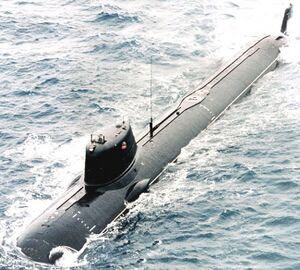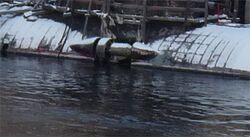Samt-class submarine
 A surfaced Samt class submarine.
| |
| Class overview | |
|---|---|
| Name: | Samt-class hydrographic research submarine |
| Builders: | Tartous Naval Shipyard |
| Operators: |
|
| Succeeded by: | Mushour class |
| Cost: | Est. $310 million in 2004 dollars |
| Built: | 1985-2000 |
| In service: | 1991-present |
| Planned: | 3 |
| Completed: | 3 |
| Active: | 3 |
| General characteristics | |
| Displacement: |
list error: <br /> list (help) 1,390 tons surfaced 2,000 tons submerged |
| Length: | 69.0 m |
| Beam: | 7.0 m |
| Draught: | 5.2 m |
| Propulsion: |
list error: <br /> list (help) MNB-29 pressurized water reactor with two turbines, 7,500 kW Single shaft with shrouded seven-bladed skewback screw, up to six vectored thrusters |
| Speed: |
list error: <br /> list (help) ~30 knots maximum submerged ~20 knots maximum surfaced |
| Range: | unlimited |
| Endurance: | ~56 days at max crew, ~162 days max |
| Test depth: | 1,000 meters |
| Complement: | 12 (all officers), up to 36 total |
| Sensors and processing systems: |
list error: <br /> list (help) SKh-22 'Muzayrib' sonar system NHB-120 environmental sensor |
The Samt-class (Arabic: سمت, English: Azimuth) is a class of three deep-diving nuclear submarines used by the Riysian Navy, first entering service in 1991. Officially used for "hydrographic research", these submarines are believed to be used for underwater engineering and special operations on the seafloor, in conjunction with the smaller Ghadeer-class submarines.
All submarines of the class are currently assigned to the 65th Submarine Brigade, under the command of the 829th Naval Flotilla.
History
Design
Hull
The Samt-class of submarines are around 69 meters long and up to 7 meters wide, with an estimated displacement of 1,390 tonnes surfaced and 2,000 tonnes submerged, giving it a high buoyancy reserve. Though relatively small compared to most nuclear submarines - being around the same size as a diesel-electric - they are still larger than their Ghadeer-class or NR-1 counterparts, with their size allowing for two full decks rather than just one.
Like most Riysian submarines, submarines of this class are believed to use a double-hull construction, with both hulls made out of strong yet lightweight titanium rather than steel. This design allows Samt-class submarines to safely dive much deeper than their attack counterparts, with an estimated test depth of around 1,000 meters, allowing them greater access to the deep sea and seabed. Additionally, titanium is non-magnetic, giving the Samt class a very small magnetic signature. The inner hull is in fact split into two separate compartments, the rear one only accessible in port and containing the reactor and machinery, and the front compartment containing everything else.
Though acoustic stealth was not a major consideration in its design due to its non-combat role, some quieting features were implemented on the Samt-class submarines. The hull is covered with thick Riysian standard anechoic tiles, which dampens self-noise and reduces sonar reflectivity. Rafting of the inner sections of the hull is also believed to have been used. Compared to the Saif al-Bahr attack submarine, a Samt-class submarine is around 10 times louder, with a noise level similar to the second generation of Riysian nuclear attack submarines.
Powerplant and propulsion
Power on board the Samt class is provided by a MNB-29 pressurized water reactor, designed by the Riadi Design Bureau. This highly miniaturized reactor, developed specifically for special missions submarine use, provides a relatively high maximum output of 7,500 kilowatts. This gives Samt-class submarines a power to weight ratio comparable to a true nuclear attack submarine.
The nuclear reactor on board the submarines drives a single shaft, with a seven-bladed skewback screw shrouded to protect it against foreign object damage. The screw is believed to be the same one used on the diesel-electric Gh-210 submarines, done to save money on research and development and to simplify logistics. A side benefit of using that screw is reduced submarine noise and cavitation, compared to the more basic four-bladed screw of the Ghadeer-class. Maximum submerged speed of the Samt-class is estimated to be around 30 knots, while maximum surfaced speed is estimated to be around 20 knots.
In addition to the main screw, it appears that Samt-class submarines also have six independently vectored thrusters, with two on either side of a submarine, and two on its deck. When not in use, they are retracted into covers on the outer hull. This gives them high manuverability and allows for effective station keeping, which is important during underwater engineering projects.
Crew
Samt-class submarines have a minimum crew requirement of 12, but can carry up to 36 people, which can include scientists, technical specialists, divers, and others. Having been designed for independent, extended operations, these submarines have high endurance, with an estimated 162 days of supplies at minimum staffing, and still a respectable 56 days with a full crew. Furthermore, thanks to its size, the Samt-class offers a high level of crew comfort comparable to a conventional attack submarine.
To maximize utilization, each Samt-class submarine has two crews similar to ballistic missile subs. These crews rotate with each other between missions, and assist each other in maintenance, so that one crew is always recovering and/or retraining, while a fresh crew mans the submarine.
Mission equipment
Due to its mission, details about the Samt-class' equipment is limited, particularly in regards to its electronics. Compared to a typical submarine however, these submarines are believed to have plenty of additional features supporting their roles in surveillance and deep sea engineering, both physical and electronic.
Physical equipment
To allow it to rest on the seafloor for undersea engineering, the Samt-class is believed to have four retractable legs embedded into the outer hull. Additionally, these submarines are suspected of having a lock-out capability, which allows for the deployment of divers underwater.
The retrieval, placement, and manipulation of objects on the ocean floor is an important part of all Riysian special missions submarines, especially the Samt-class, with its larger size allowing for more extensive equipment than the smaller Ghadeer-class. Equipment appears to consist of a pair of manipulators
Electronics
A large array of forward-mounted chemical lights provides illumination for the working area.
Sonar
Submarines
| Name | Translation/Namesake | Pennant Number | Builder | Laid down | Launched | Commissioned | Unit | Status |
|---|---|---|---|---|---|---|---|---|
| Samt (سمت) | Azimuth | B-502 | Tartous Naval Shipyard, Tartous | 12 August 1985 | 9 September 1990 | 26 November 1991 | 65th Submarine Brigade | Active, in service |
| Bousuleh (بوصلة) | Compass | B-693 | Tartous Naval Shipyard, Tartous | 10 January 1991 | 4 January 1996 | 2 April 1997 | 65th Submarine Brigade | Active, in service |
| Malah (ملاح) | Navigator | B-462 | Tartous Naval Shipyard, Tartous | 17 March 1996 | 3 December 2000 | 18 April 2001 | 65th Submarine Brigade | Active, in service |

